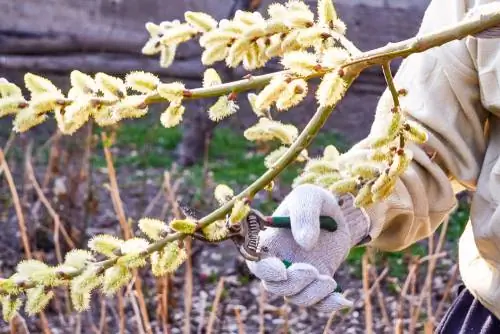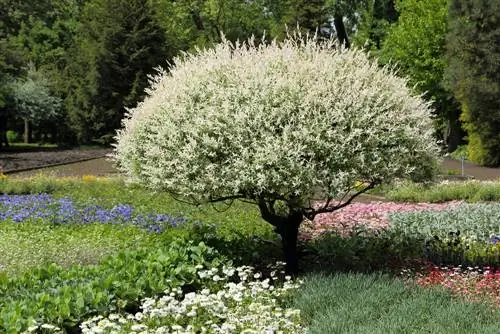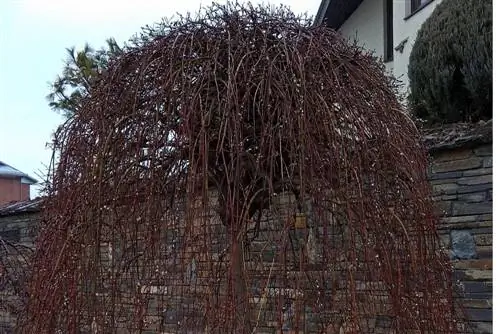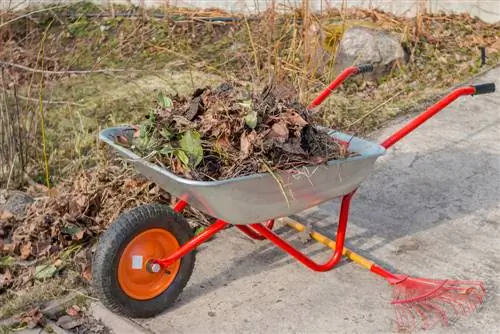- Author admin [email protected].
- Public 2023-12-16 16:46.
- Last modified 2025-01-23 11:21.
With natural charm, pussy willows decorate the spring garden without requiring extensive care. The picturesque floral display of fluffy catkins lasts for many years if the native shrub receives regular pruning care. Read this guide to find out when and how to properly cut a pussy willow.
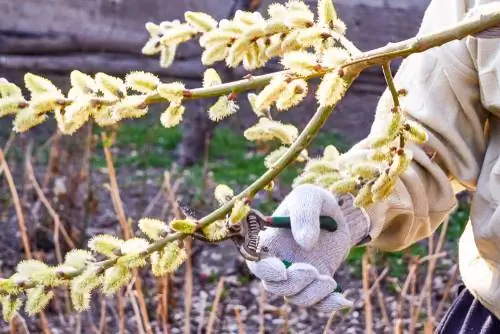
When and how should you cut pussy willows?
To prune pussy willows correctly, carry out topiary pruning after the flowering period, shortening shoots if necessary. Make a thinning cut in late winter between January and March to remove dead wood and weak branches. Hanging catkinseed willows also require annual pruning.
Cutting pussy willows after flowering
Willows produce flower buds the previous year. With this in mind, you only give the wild, romantic ornamental tree a shape-giving cut after it has flowered. The good-natured pruning tolerance in combination with rapid annual growth results in a wide scope for discretion in pruning. How to properly cut a pussy willow:
- Create every year or only when necessary
- Short excessively long shoots that protrude out of shape to the desired length
- Choose a conveniently positioned eye as the cutting point and cut at a distance of 3-5 mm
It is up to your expert assessment whether you shorten branches and twigs a little or up to two thirds. As long as at least one or two leaves or leaf nodes remain on the shoot, the willow will continue to grow happily at this point.
Lighten out from time to time
The perfect pruning care for a catkin willow consists of regular topiary pruning after the flowering period and an occasional thinning pruning during the leafless winter period. It is important to prevent the accumulation of dead wood in the bush. Light-flooded growth is the basic requirement for an opulent catkin flower. How to do it correctly:
- Best date is in late winter between January and March
- Wait for a day with frost-free, dry weather
- Cut off dead shoots at the base
- Cut off inward-facing, cross-growing or weak branches
Please don't be tempted to combine both types of cuts for the sake of effectiveness. A topiary cut in late winter destroys the majority of established buds for the velvety spring blossoms. If you make the thinning cut after the flowering period, you will collide with the regulations in the Federal Nature Conservation Act, which stipulates the start of the closed season from March 1st.
Cut the hanging catkinseed willow heavily
In the small garden, the hanging catkinse willow 'Pendula' shines as a chic tree with a richly blooming hanging crown. The growth as a combination of trunk and noble crown requires annual pruning. For this purpose, after the flowering period, cut all shoots back to two to four leaves or leaf nodes.
The powerful cut causes adequate growth of up to 50 centimeters annually. The stylish silhouette as a hanging willow is therefore restored within a short time. At the same time, you create space for numerous young shoots that will present velvety, shimmering catkin flowers next spring.
Tip
A common reason to devote yourself to pussy willows with scissors is to breed more specimens. If a vital catkin willow thrives in your green kingdom, you can propagate the distinctive ornamental tree with cuttings in no time. Cut semi-lignified shoots 20 to 30 centimeters long in early summer. Place two thirds of their length in a bright, protected propagation bed or a pot with potting soil.

